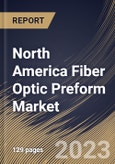Optical fibers have developed extraordinarily in optical communication over the past two decades. Today, the annual production of fibers exceeds 200 million kilometers. Optic communication networks serve as the fundamental infrastructure supporting the contemporary information society. This success can be attributed to the practical advancement of exceptional materials and the capacity to customize structural characteristics in contemporary optical fibers, predominantly silica optical fibers.
The incredibly high quality of light confinement over virtually infinite distances is due to the principle of guided light. The performance of an optical fiber largely determines its quality. Established methods for fabricating preforms, such as the rod-in-tube and vapor deposition methods, are primarily used for telecommunication applications. On the other hand, unconventional methods are employed to create preforms for specialty fibers, including stack-and-draw, powder sinter, and melt glass methods.
Fiber optic preforms demand is increasing in America's military and aviation sectors. According to the Federal Aviation Administration, on average, over 29 million square miles of airspace are traversed by around 44,000 flights carrying 2.7 million passengers. To ensure a safe and efficient flight operation, the airplane's preparation to depart the runway, take off, fly through the atmosphere, and land at its destination necessitates utilizing various personnel, technologies, and services. Thus, the rising demand for fiber optics in the telecommunication and military and aviation sectors is increasing the growth of the market in the region.
The US market dominated the North America Fiber Optic Preform Market, by Country in 2022, and would continue to be a dominant market till 2030; thereby, achieving a market value of $3,363.7 Million by 2030. The Canada market is registering a CAGR of 22.6% during (2023 - 2030). Additionally, The Mexico market would showcase a CAGR of 21.5% during (2023 - 2030).
Based on Process, the market is segmented into VAD, OVD, PCVD, and MCVD. Based on End-user, the market is segmented into Telecom, Oil & Gas, Military & Aerospace, BFSI, Railway, Medical, and Others. Based on Type, the market is segmented into Multi-Mode, Single-Mode, and Plastic Optical Fiber. Based on countries, the market is segmented into U.S., Mexico, Canada, and Rest of North America.
The market research report covers the analysis of key stake holders of the market. Key companies profiled in the report include Corning Incorporated, Optical Cable Corporation, Sterlite Technologies Limited, Prysmian Group, Furukawa Electric Co., Ltd., Sumitomo Electric Industries, Ltd., Yangtze Optical Fibre and Cable Joint Stock Limited Company, Hengtong Group Co., Ltd., Fujikura Ltd. and Shin-Etsu Chemical Co., Ltd.
Scope of the Study
Market Segments Covered in the Report:
By Process- VAD
- OVD
- PCVD
- MCVD
- Telecom
- Oil & Gas
- Military & Aerospace
- BFSI
- Railway
- Medical
- Others
- Multi-Mode
- Single-Mode
- Plastic Optical Fiber
- US
- Canada
- Mexico
- Rest of North America
Key Market Players
List of Companies Profiled in the Report:
- Corning Incorporated
- Optical Cable Corporation
- Sterlite Technologies Limited
- Prysmian Group
- Furukawa Electric Co., Ltd.
- Sumitomo Electric Industries, Ltd.
- Yangtze Optical Fibre and Cable Joint Stock Limited Company
- Hengtong Group Co., Ltd.
- Fujikura Ltd.
- Shin-Etsu Chemical Co., Ltd.
Unique Offerings
- Exhaustive coverage
- The highest number of Market tables and figures
- Subscription-based model available
- Guaranteed best price
- Assured post sales research support with 10% customization free
Table of Contents
Companies Mentioned
- Corning Incorporated
- Optical Cable Corporation
- Sterlite Technologies Limited
- Prysmian Group
- Furukawa Electric Co., Ltd.
- Sumitomo Electric Industries, Ltd.
- Yangtze Optical Fibre and Cable Joint Stock Limited Company
- Hengtong Group Co., Ltd.
- Fujikura Ltd.
- Shin-Etsu Chemical Co., Ltd.
Methodology

LOADING...








